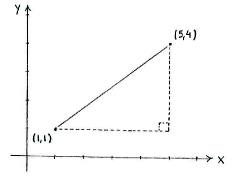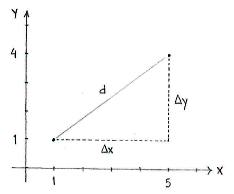Lösung 4.1:4a
Aus Online Mathematik Brückenkurs 1
(Unterschied zwischen Versionen)
K |
|||
| Zeile 1: | Zeile 1: | ||
| - | If we draw in the points in a coordinate system, we can see the line between the points as the hypotenuse in an imaginary right-angled triangle, where the opposite and adjacent are parallel with the | + | If we draw in the points in a coordinate system, we can see the line between the points as the hypotenuse in an imaginary right-angled triangle, where the opposite and adjacent are parallel with the ''x''- and ''y''-axes, respectively. |
| - | + | ||
| - | - and | + | |
| - | + | ||
| - | -axes. | + | |
| - | {{NAVCONTENT_START}} | ||
[[Image:4_1_4_a-1(2)_1.gif|center]] | [[Image:4_1_4_a-1(2)_1.gif|center]] | ||
| - | In this triangle, it is easy to measure the lengths of the opposite and the adjacent, which are simply the distances between the points in the | ||
| - | <math>x</math> | ||
| - | - | ||
| - | <math>y</math> | ||
| - | -directions. | ||
| - | [[Image:4_1_4_a-1(2)_2.gif|center]] | ||
| + | In this triangle, it is easy to measure the lengths of the opposite and the adjacent, which are simply the distances between the points in the ''x''- and ''y''-directions, respectively. | ||
| - | {{NAVCONTENT_STOP}} | ||
| - | + | {| align="center" | |
| + | |align="center"|[[Image:4_1_4_a-1(2)_2.gif|center]] | ||
| + | |- | ||
| + | |align="center"|<small>∆''x'' = 5 - 1 = 4 and ∆''y'' = 4 - 1 = 3</small> | ||
| + | |} | ||
| - | + | Using the Pythagorean theorem, we can then calculate the length of the hypotenuse, which is also the distance between the points: | |
| - | + | ||
| - | + | ||
| - | + | ||
| + | {{Displayed math||<math>\begin{align} | ||
| + | d &= \sqrt{(\Delta x)^2 + (\Delta y)^2} = \sqrt{4^2+3^2}\\[5pt] | ||
| + | &= \sqrt{16+9} = \sqrt{25} = 5\,\textrm{.} | ||
| + | \end{align}</math>}} | ||
| - | NOTE: In general, the distance between two points | ||
| - | <math>\left( x \right.,\left. y \right)</math> | ||
| - | and | ||
| - | <math>\left( a \right.,\left. b \right)</math> | ||
| - | is given by the formula | ||
| + | Note: In general, the distance between two points <math>(x,y)</math> and <math>(a,b)</math> is given by the formula | ||
| - | <math>d=\sqrt{ | + | {{Displayed math||<math>d = \sqrt{(x-a)^2 + (y-b)^2}\,\textrm{.}</math>}} |
Version vom 10:40, 3. Okt. 2008
If we draw in the points in a coordinate system, we can see the line between the points as the hypotenuse in an imaginary right-angled triangle, where the opposite and adjacent are parallel with the x- and y-axes, respectively.
In this triangle, it is easy to measure the lengths of the opposite and the adjacent, which are simply the distances between the points in the x- and y-directions, respectively.
| ∆x = 5 - 1 = 4 and ∆y = 4 - 1 = 3 |
Using the Pythagorean theorem, we can then calculate the length of the hypotenuse, which is also the distance between the points:
Note: In general, the distance between two points \displaystyle (x,y) and \displaystyle (a,b) is given by the formula


